Input interpretation

CH_3CH_3 ethane + O_2 oxygen ⟶ CO_2 carbon dioxide + H_2O water
Balanced equation
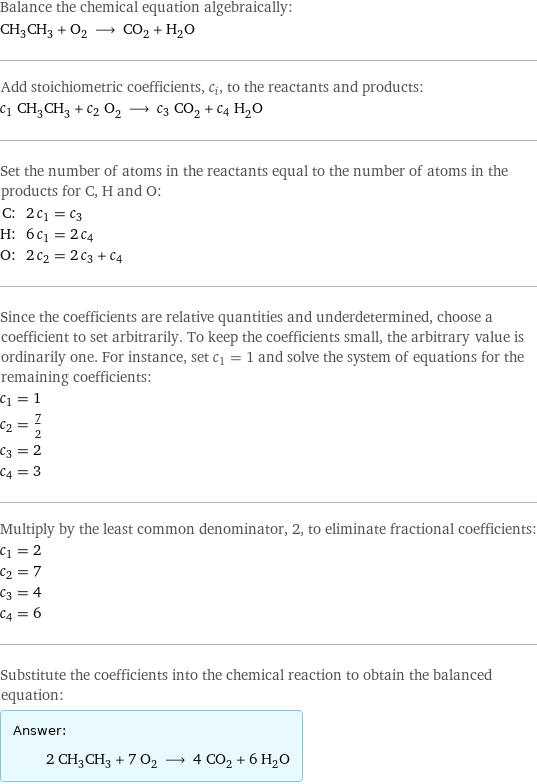
Balance the chemical equation algebraically: CH_3CH_3 + O_2 ⟶ CO_2 + H_2O Add stoichiometric coefficients, c_i, to the reactants and products: c_1 CH_3CH_3 + c_2 O_2 ⟶ c_3 CO_2 + c_4 H_2O Set the number of atoms in the reactants equal to the number of atoms in the products for C, H and O: C: | 2 c_1 = c_3 H: | 6 c_1 = 2 c_4 O: | 2 c_2 = 2 c_3 + c_4 Since the coefficients are relative quantities and underdetermined, choose a coefficient to set arbitrarily. To keep the coefficients small, the arbitrary value is ordinarily one. For instance, set c_1 = 1 and solve the system of equations for the remaining coefficients: c_1 = 1 c_2 = 7/2 c_3 = 2 c_4 = 3 Multiply by the least common denominator, 2, to eliminate fractional coefficients: c_1 = 2 c_2 = 7 c_3 = 4 c_4 = 6 Substitute the coefficients into the chemical reaction to obtain the balanced equation: Answer: | | 2 CH_3CH_3 + 7 O_2 ⟶ 4 CO_2 + 6 H_2O
Structures

+ ⟶ +
Names

ethane + oxygen ⟶ carbon dioxide + water
Reaction thermodynamics
Enthalpy
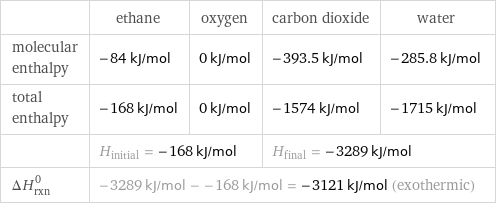
| ethane | oxygen | carbon dioxide | water molecular enthalpy | -84 kJ/mol | 0 kJ/mol | -393.5 kJ/mol | -285.8 kJ/mol total enthalpy | -168 kJ/mol | 0 kJ/mol | -1574 kJ/mol | -1715 kJ/mol | H_initial = -168 kJ/mol | | H_final = -3289 kJ/mol | ΔH_rxn^0 | -3289 kJ/mol - -168 kJ/mol = -3121 kJ/mol (exothermic) | | |
Gibbs free energy
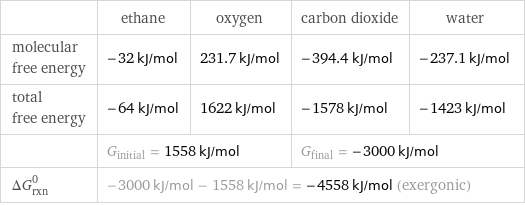
| ethane | oxygen | carbon dioxide | water molecular free energy | -32 kJ/mol | 231.7 kJ/mol | -394.4 kJ/mol | -237.1 kJ/mol total free energy | -64 kJ/mol | 1622 kJ/mol | -1578 kJ/mol | -1423 kJ/mol | G_initial = 1558 kJ/mol | | G_final = -3000 kJ/mol | ΔG_rxn^0 | -3000 kJ/mol - 1558 kJ/mol = -4558 kJ/mol (exergonic) | | |
Entropy
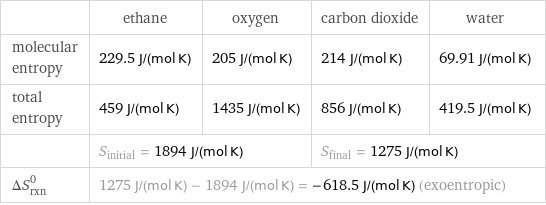
| ethane | oxygen | carbon dioxide | water molecular entropy | 229.5 J/(mol K) | 205 J/(mol K) | 214 J/(mol K) | 69.91 J/(mol K) total entropy | 459 J/(mol K) | 1435 J/(mol K) | 856 J/(mol K) | 419.5 J/(mol K) | S_initial = 1894 J/(mol K) | | S_final = 1275 J/(mol K) | ΔS_rxn^0 | 1275 J/(mol K) - 1894 J/(mol K) = -618.5 J/(mol K) (exoentropic) | | |
Equilibrium constant
![Construct the equilibrium constant, K, expression for: CH_3CH_3 + O_2 ⟶ CO_2 + H_2O Plan: • Balance the chemical equation. • Determine the stoichiometric numbers. • Assemble the activity expression for each chemical species. • Use the activity expressions to build the equilibrium constant expression. Write the balanced chemical equation: 2 CH_3CH_3 + 7 O_2 ⟶ 4 CO_2 + 6 H_2O Assign stoichiometric numbers, ν_i, using the stoichiometric coefficients, c_i, from the balanced chemical equation in the following manner: ν_i = -c_i for reactants and ν_i = c_i for products: chemical species | c_i | ν_i CH_3CH_3 | 2 | -2 O_2 | 7 | -7 CO_2 | 4 | 4 H_2O | 6 | 6 Assemble the activity expressions accounting for the state of matter and ν_i: chemical species | c_i | ν_i | activity expression CH_3CH_3 | 2 | -2 | ([CH3CH3])^(-2) O_2 | 7 | -7 | ([O2])^(-7) CO_2 | 4 | 4 | ([CO2])^4 H_2O | 6 | 6 | ([H2O])^6 The equilibrium constant symbol in the concentration basis is: K_c Mulitply the activity expressions to arrive at the K_c expression: Answer: | | K_c = ([CH3CH3])^(-2) ([O2])^(-7) ([CO2])^4 ([H2O])^6 = (([CO2])^4 ([H2O])^6)/(([CH3CH3])^2 ([O2])^7)](../image_source/91d80f5e3646e7d9fcc822d9618fd2b6.png)
Construct the equilibrium constant, K, expression for: CH_3CH_3 + O_2 ⟶ CO_2 + H_2O Plan: • Balance the chemical equation. • Determine the stoichiometric numbers. • Assemble the activity expression for each chemical species. • Use the activity expressions to build the equilibrium constant expression. Write the balanced chemical equation: 2 CH_3CH_3 + 7 O_2 ⟶ 4 CO_2 + 6 H_2O Assign stoichiometric numbers, ν_i, using the stoichiometric coefficients, c_i, from the balanced chemical equation in the following manner: ν_i = -c_i for reactants and ν_i = c_i for products: chemical species | c_i | ν_i CH_3CH_3 | 2 | -2 O_2 | 7 | -7 CO_2 | 4 | 4 H_2O | 6 | 6 Assemble the activity expressions accounting for the state of matter and ν_i: chemical species | c_i | ν_i | activity expression CH_3CH_3 | 2 | -2 | ([CH3CH3])^(-2) O_2 | 7 | -7 | ([O2])^(-7) CO_2 | 4 | 4 | ([CO2])^4 H_2O | 6 | 6 | ([H2O])^6 The equilibrium constant symbol in the concentration basis is: K_c Mulitply the activity expressions to arrive at the K_c expression: Answer: | | K_c = ([CH3CH3])^(-2) ([O2])^(-7) ([CO2])^4 ([H2O])^6 = (([CO2])^4 ([H2O])^6)/(([CH3CH3])^2 ([O2])^7)
Rate of reaction
![Construct the rate of reaction expression for: CH_3CH_3 + O_2 ⟶ CO_2 + H_2O Plan: • Balance the chemical equation. • Determine the stoichiometric numbers. • Assemble the rate term for each chemical species. • Write the rate of reaction expression. Write the balanced chemical equation: 2 CH_3CH_3 + 7 O_2 ⟶ 4 CO_2 + 6 H_2O Assign stoichiometric numbers, ν_i, using the stoichiometric coefficients, c_i, from the balanced chemical equation in the following manner: ν_i = -c_i for reactants and ν_i = c_i for products: chemical species | c_i | ν_i CH_3CH_3 | 2 | -2 O_2 | 7 | -7 CO_2 | 4 | 4 H_2O | 6 | 6 The rate term for each chemical species, B_i, is 1/ν_i(Δ[B_i])/(Δt) where [B_i] is the amount concentration and t is time: chemical species | c_i | ν_i | rate term CH_3CH_3 | 2 | -2 | -1/2 (Δ[CH3CH3])/(Δt) O_2 | 7 | -7 | -1/7 (Δ[O2])/(Δt) CO_2 | 4 | 4 | 1/4 (Δ[CO2])/(Δt) H_2O | 6 | 6 | 1/6 (Δ[H2O])/(Δt) (for infinitesimal rate of change, replace Δ with d) Set the rate terms equal to each other to arrive at the rate expression: Answer: | | rate = -1/2 (Δ[CH3CH3])/(Δt) = -1/7 (Δ[O2])/(Δt) = 1/4 (Δ[CO2])/(Δt) = 1/6 (Δ[H2O])/(Δt) (assuming constant volume and no accumulation of intermediates or side products)](../image_source/4d8b84f20ebef89af9d82e64281dc239.png)
Construct the rate of reaction expression for: CH_3CH_3 + O_2 ⟶ CO_2 + H_2O Plan: • Balance the chemical equation. • Determine the stoichiometric numbers. • Assemble the rate term for each chemical species. • Write the rate of reaction expression. Write the balanced chemical equation: 2 CH_3CH_3 + 7 O_2 ⟶ 4 CO_2 + 6 H_2O Assign stoichiometric numbers, ν_i, using the stoichiometric coefficients, c_i, from the balanced chemical equation in the following manner: ν_i = -c_i for reactants and ν_i = c_i for products: chemical species | c_i | ν_i CH_3CH_3 | 2 | -2 O_2 | 7 | -7 CO_2 | 4 | 4 H_2O | 6 | 6 The rate term for each chemical species, B_i, is 1/ν_i(Δ[B_i])/(Δt) where [B_i] is the amount concentration and t is time: chemical species | c_i | ν_i | rate term CH_3CH_3 | 2 | -2 | -1/2 (Δ[CH3CH3])/(Δt) O_2 | 7 | -7 | -1/7 (Δ[O2])/(Δt) CO_2 | 4 | 4 | 1/4 (Δ[CO2])/(Δt) H_2O | 6 | 6 | 1/6 (Δ[H2O])/(Δt) (for infinitesimal rate of change, replace Δ with d) Set the rate terms equal to each other to arrive at the rate expression: Answer: | | rate = -1/2 (Δ[CH3CH3])/(Δt) = -1/7 (Δ[O2])/(Δt) = 1/4 (Δ[CO2])/(Δt) = 1/6 (Δ[H2O])/(Δt) (assuming constant volume and no accumulation of intermediates or side products)
Chemical names and formulas
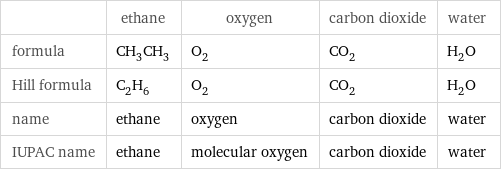
| ethane | oxygen | carbon dioxide | water formula | CH_3CH_3 | O_2 | CO_2 | H_2O Hill formula | C_2H_6 | O_2 | CO_2 | H_2O name | ethane | oxygen | carbon dioxide | water IUPAC name | ethane | molecular oxygen | carbon dioxide | water